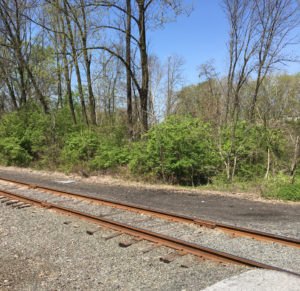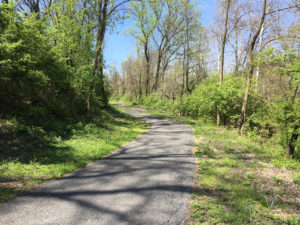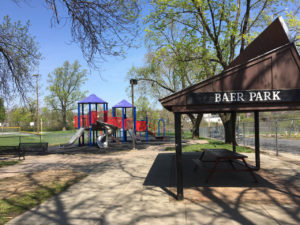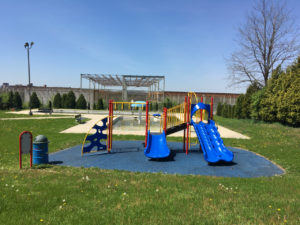Historically, the most vital and noticeable construction through the Reading area has been railroads. As part of the Philadelphia and Reading Railroad (P&R), incorporated in 1833, much of the town has been covered with railroads until the P&R railroad filed for bankruptcy protection in 1971. The railroad in the Northwest Reading neighborhood runs along the Schuylkill River, which leads to the neighboring cities of Pottsville, Pottstown and Philadelphia. This railroad was also located directly next to Parish Steel (later Dana Corp.), becoming vital to the neighborhood’s industry. (ReadingPa.gov, n.d.)

This railroad has been an important part of the neighborhood, as it was used by the Reading Iron Company and Carpenter Technology in the transport of iron and steel, and Reading Anthracite Company in transportation of anthracite from the northern Coal Region counties to Reading and the southern states. A passenger line to and from Philadelphia in 1833 made the neighborhood a hotbed for railroad use (ReadingPa.gov, n.d.).
This usage continued well into the 20th century, even after the Philadelphia and Reading Railroad Company was renamed the Reading Company in 1923. The reason for the name change was to streamline the company’s corporate structure after World War I, when the railroads were no longer under government control and lines were becoming electrified. This period right after World War I was the company’s best years. However, industrial railroad use decreased significantly after World War II when the demand for anthracite fell sharply (ReadingPa.gov, n.d.).
For the next two decades, this decline slowly ate away at the Reading Company’s profits, until the Reading Company finally filed for bankruptcy in 1971, and sold all its railway lines to Consolidated Rail Corporation (Conrail), and subsequently the Reading lines were sold to Virginia-based freighter Norfolk Southern in 1997, including the rails in Northwest Reading (Alecknavage II, 2003).
In or before the first decade of the twentieth century, much of the railways in the area were abandoned. One can see remnants of these former lines running through neighborhood streets, such as Buttonwood Street. Since then, many of the other abandoned lines have been paved over, while others that have not are largely grown over with brush. According to former Reading mayor Tom McMahon, mayor of Reading from 2004-2012, the Norfolk Southern rail is still active and used a few times a week (T. McMahon, personal communication, March 13, 2017).

Another major infrastructure fixture in northwest Reading is the Schuylkill River Trail, a 140-mile trail that extends from Pottsville to Philadelphia. One mile of the trail runs through Northwest Reading along River Road, with its entrance behind Baer Park. On this section, one can see remnants of the former Schuylkill Canal, a historic canal that was in operation from 1825 to 1931. The beautiful Kissinger’s Lock (Lock 45), which officially ceased boat traffic in 1945 (Wenrich, 2009; Youker, 2009), also is preserved along the river.
Roads
There are two bridges in the neighborhood: the Schuylkill Avenue Bridge which interchanges with the Warren Street Bypass and into Glenside, and the Buttonwood Bridge from Reading to West Reading. The Schuylkill Avenue Bridge was a large undertaking as part of the Warren Street Bypass extension. The bridge had been around since the 1910s as a river crossing, but had not been connected to any major road. Before 1950 when the extension’s construction began, Schuylkill Avenue was a dead end from Warren Street. The bridge’s construction was met with opposition, as it cut through a residential area (Glenside), whose residents did not want housing values to drop because of heavy traffic. Despite the opposition, the extension was completed in 1957 (Go Reading Berks, 2013).
The Buttonwood Street Bridge was opened in the early 1930s, but was largely neglected in its history. According to the Reading Eagle, no major work had been done on the bridge since the 1970s until recently. In fact, both bridges had major deterioration problems. As of this writing, both bridges have been under renovation to repair the structural damage, forcing the Buttonwood Street Bridge to close temporarily for repairs (Migdail-Smith, 2015).
We have observed that many roads in the neighborhood have largely been neglected as well, as they are worn and rough to drive over. Aside from the major roads like Buttonwood Street and River Road, many of the roads are extremely narrow and were widened in order to simply make room for the two bridges.
Parks

The largest park in Northwest Reading is Baer Park, located on Clinton Street directly in front of Northwest Elementary School. According to the Berks History Center, the park was built in 1938, and the fieldhouse was built from the remains of the Berks County Prison at Penn’s Common after its closure in 1932 and its subsequent teardown in 1936 (“Berks County Prison in Penn’s Common (City Park Annals – Part III)”, n.d.).
The other main park in Northwest Reading is Lauer’s Park, built by Frederick Lauer largely as a place of worship for him and his fellow German residents in the neighborhood, and one section has a recreational area for the community as a whole. After his death in 1883, the park was converted into a baseball stadium where semi-professional teams practiced and played into the 20th century (Kuhn, 1992). This baseball park predates all of the professional baseball stadiums nationally, including Baker Bowl (built in 1895) and Forbes Field (built in 1909), two fields commonly referred to as the earliest official baseball fields built (Go Reading Berks, 2012).

One long-standing fixture in the neighborhood is the Clinton Street swimming pool. The original pool was built by the men and boys of the Olivet Boys Club in 1921. The Olivet Clinton Street pool was the first desegregated pool in the city. (Hunsicker and Hoffman, 2016) Originally, girls were not allowed to be members of the club or to swim in the pool, although there are many photos showing girls in the pool. The pool became an extremely popular site for many athletic events such as swimming, diving, and water polo (Unruh, 2016). Today, the Clinton Street pool is one of the only pools in Reading.

